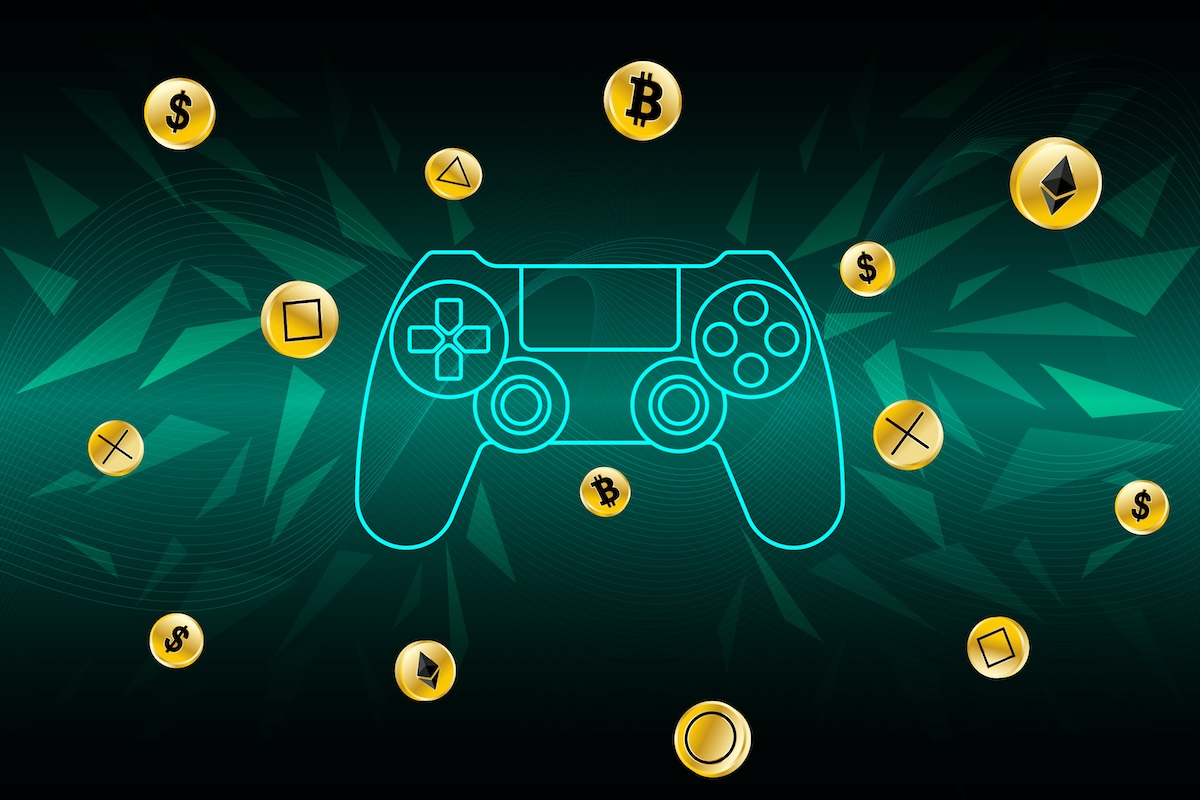Blockchain gaming integrates blockchain technology into video games, allowing players to own, trade, and monetize in-game assets using NFTs and cryptocurrencies. Unlike traditional games, where assets are restricted to the game, blockchain games provide genuine ownership and the ability to transfer digital items.
Market Overview and Growth
The blockchain gaming market is seeing major growth. In 2022, it was $4.83 billion and is projected to be $301.53 billion by 2030, with a CAGR of 68.3% from 2023 to 2030.
This growth is driven by demand for decentralized games, NFTs, and cryptocurrencies, as well as big investments in blockchain gaming startups.
Types of Investments
Blockchain gaming is a broad landscape for investors to play in. Here’s an expanded breakdown of the investment opportunities:
1. In-Game Assets
Investing in in-game assets means buying NFTs that represent unique items within a game. These assets include:
- Virtual Land: Digital real estate within virtual worlds, such as parcels in The Sandbox or Decentraland, which can be developed, leased or sold.
- Characters and Avatars: Unique game characters that can be used or traded.
- Items and Accessories: Special weapons, skins or tools that enhance gameplay and can be bought or sold in secondary markets.
The value of these assets is often driven by scarcity, utility within the game and demand from the player community. Investors can profit by trading these assets as their value increases over time.
2. Tokens and Cryptocurrencies
Many blockchain games have their own tokens that serve as in-game currency or provide governance rights. Examples:
- AXS (Axie Infinity Shards): The governance token for Axie Infinity, to participate in decision making.
- MANA: The cryptocurrency used in Decentraland for transactions and buying virtual land.
Investing in these tokens gives you exposure to the game’s economy. As the game grows and its user base increases, the demand for its native token may rise and value may appreciate.
3. Equity in Gaming Companies
Investors can buy equity in companies developing blockchain games through:
- Crowdfunding Platforms: Participating in early funding rounds for startups.
- Private Equity: Investing in established companies looking for capital to scale.
This way you benefit from the overall growth and success of the company, beyond individual game assets or tokens.
4. Metaverse Investments
The metaverse is a collection of interconnected virtual worlds where users can interact, work and play. Investing in metaverse projects that have gaming elements gives you diversified exposure to the wider virtual economy. Opportunities:
- Virtual Real Estate: Buying land in metaverse platforms to develop or lease.
- Metaverse Tokens: Buying tokens associated with metaverse projects, such as SAND for The Sandbox.
These investments are betting on the digital convergence trend where gaming, social interaction and commerce meet in virtual spaces.
How to Start Investing in Blockchain Gaming
Research the Industry
Research is key to investing. Here’s how you can do it:
Use Trusted Platforms: DappRadar has real-time data on blockchain games, user activity, trading volume and rankings. NFT News Today has the latest news, project updates and expert analysis.
Analyze Community Engagement: A project with an active community is often a good sign. Discord, Telegram and Twitter are great places to check community sentiment.
Evaluate the Team: Look for projects led by experienced teams with clear goals. Knowing who is behind the project gives you confidence in its viability.
Review the Game’s Roadmap: A detailed roadmap with milestones is a sign of a project’s commitment to long term success.
2. Set Budget and Risk Tolerance
Before you invest, assess your financial situation and set clear limits to protect yourself from losses:
How Much Can You Afford to Lose: Blockchain gaming investments, especially NFTs and tokens can be speculative. Only invest money you can afford to lose.
Diversify Your Portfolio: Don’t put all your eggs in one basket. Spread your investments across multiple games, tokens or asset types to minimize risk.
Know Your Risk: If you’re risk averse, focus on established projects with a track record. If you have a higher risk tolerance, you might look into newer, high-potential games.
3. Choose Your Investment Strategy
Your strategy will depend on your financial goals and level of involvement:
Long-Term Holding: This strategy involves buying assets like NFTs or tokens and holding onto them for extended periods, hoping their value will appreciate as the game or ecosystem grows. This is for investors who want less active management.
Short-Term Trading: Active investors can trade on market trends and asset price fluctuations by buying and selling tokens or NFTs frequently. This requires close monitoring of the market.
Combining Strategies: Some investors use a mix of long-term holding for steady growth and short-term trading for quick profits.
4. Use the Right Tools
You need the right tools to manage and secure your investments:
Trading Platforms: Marketplaces like OpenSea and exchanges like Binance are the places to trade NFTs and cryptocurrencies. These platforms give you access to a wide range of assets so you can explore and trade easily.
Wallets: Store your tokens and NFTs in secure wallets. Hardware wallets like Ledger and Trezor for offline storage or software wallets like MetaMask and Trust Wallet for ease of use.
Tracking: Apps and platforms like CoinMarketCap to track your portfolio and market movements.
Risks and Challenges in Blockchain Gaming Investments
Investing in blockchain gaming is promising but comes with risks and challenges you should be aware of:
1. Market Volatility
Token and in-game asset values in blockchain gaming can fluctuate wildly due to market sentiment, tech advancements and regulatory news. During crypto market downturns many in-game assets tied to crypto can plummet in value and impact returns.
2. Scams
The blockchain gaming space has seen some shady projects, including “rug pulls” where devs abandon a project after taking investor funds. Do your due diligence to avoid getting scammed.
3. Regulatory Grey Area
The ever-changing regulatory landscape around crypto and digital assets can impact the legality and profitability of blockchain gaming investments. Changes in tax laws or government regulations can affect some companies or industries.
4. Technical Risks
Blockchain gaming projects can have technical issues, security vulnerabilities, scalability problems and development delays. Security breaches can result in asset loss, technical shortcomings can kill a project.

How to Invest
To overcome these challenges:
Do Your Due Diligence: Research the dev team, tech, community. Read the whitepaper, roadmap and partnerships to gauge the project.
Stay Informed: Follow industry news, regulatory updates and market trends. Use trusted sources and platforms to stay up to date with developments that affect your investments.
Engage with Communities: Join investor and gaming forums, social media groups and community discussions. Engage with the community to get insights and spot red flags.
Pick Good Projects: Invest in projects with clear roadmaps and experienced dev teams. Look for transparency, regular updates and a proven track record in the project’s history.
Future of Blockchain Gaming Investments
The blockchain gaming space is about to get bigger, here’s what’s driving it:
Artificial Intelligence (AI) Integration: AI is making gaming more responsive with NPCs, personalization and in-game economy optimization. For example, DeepLink is using AI to improve cloud gaming performance so high-end gaming is more accessible.
Cross-Platform Gaming: Games that work across multiple devices are expanding player bases and engagement. Blockchain enables this by allowing asset interoperability so players can use their in-game items across different platforms.
Augmented Reality (AR) Adoption: AR is combining digital and physical worlds, gaming is getting more immersive. Blockchain enables this by securing ownership and transfer of digital assets in AR environments. Companies are building AR games that use blockchain to offer unique experiences.
Final Thoughts
The blockchain gaming sector represents an exciting investment opportunity. By understanding the market, knowing the risks, and using smart investment strategies, you can successfully navigate this space. Responsible and strategic engagement is key to maximizing the potential of blockchain gaming investments.
Credit: Source link

























